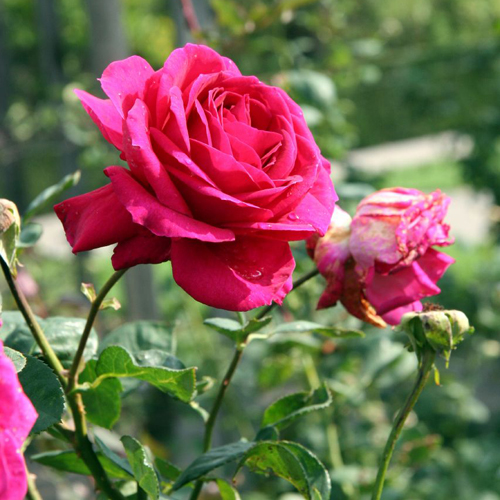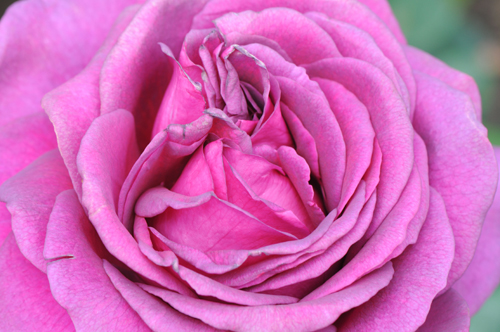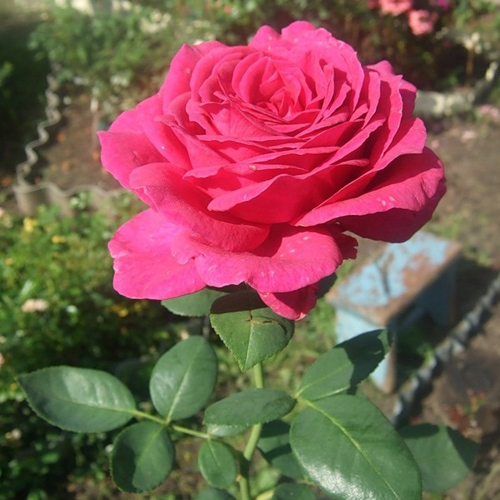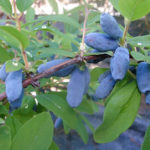Rose Big purple (Big purple)
To become really popular, the rose variety must not only have high resistance to cold and disease, but also win hearts with a truly delightful appearance and wonderful aroma. All these advantages are found in a species of noble plant called Big Pearl. She will definitely become your favorite and queen of the flower garden.

History of creation
This is a New Zealand variety from the hybrid tea group. Its creator is an amateur florist Pat Stevens, who worked in the New Zealand Rose Society, but not as a breeder, but as an ordinary secretary. Big purple appeared in 1985. In different sources, you can find other names for it: Nuit d'Orient, STEbigpu, Stephens' Big Purple. This flower has received many awards. Also in 1999 in Canada, namely in Rosexpo Montreal, he was awarded the title of "Best Purple Rose".
Description of appearance and features
Big Purple is a real beauty. The color of its large double flowers differs not only in juicy tones, but also in the ability to change under the influence of weather conditions, depending on the area of cultivation and the season. The shade of the petals can be magenta, crimson, bright purple, or have a rich fuchsia color. This rose will especially delight you with its colors in dry and cool summer. The dense buds of the flower goddess bloom slowly and exude a magical, intense, but at the same time unobtrusive scent. They develop one at each shoot and consist of 40 or more petals. The flower diameter varies from 10 to 12 cm.

The plant forms a strong bush of impressive size with erect stems. Its height ranges from 120 to 175 cm, with a maximum of 300 cm. The shrub girth is rarely more than a meter. At the base of Big Purple, the shoots are bare, but most of the plant has a grayish-green foliage.
The variety, as mentioned above, is very resistant to frost and various diseases. Unfortunately, this cannot be said about rain: under the influence of moisture, especially long-term, picturesque rose flowers lose their shape and richness of color. Therefore Big purple is best suited for dry and warm climates. In addition to the fear of precipitation, its weaknesses should also include a decrease in the number of flowers appearing on the bush by the end of the season. The flowering of the variety itself occurs in waves. It begins in late spring or with the arrival of summer and continues until the end of September. Big purples are characterized by an average degree of resistance to powdery mildew and black spot.

Growing conditions and care
To place a coquette with purple flowers, it is worth choosing a sunny place, where, nevertheless, partial shade reigns in the afternoon and, most importantly, in the midday hours. This will protect the delicate buds from burns. The area where the rose bush grows should be well ventilated. Do not place the flower in low areas.
Roses are planted in April-May. It is permissible to carry out this event in the autumn period before the onset of frost. You will need to dig a hole up to 60 cm deep with a drainage layer of small stones about 10 cm thick at the bottom. The soil in the hole is laid fertile, loose, with a pH in the range of 5.6-6.5.
Caring for Big Pearls consists of standard activities: weekly watering with soft, not cold water (15-20 liters per bush), regular loosening of the soil under a flower, weeding and dressing. Fertilizers are applied in the spring and throughout the summer. In the first case, the emphasis is on mixtures rich in phosphorus, in the second, potash concentrates are used. Frequency of the procedure: once every 15 days.
Pruning is required for the variety. It can be formative or flowering. It is produced in the spring.In the fall, diseased rose shoots are removed and the bush is thinned out. During the summer, faded buds are removed to stimulate the appearance of new flowers.
Despite the resistance of Big Pearls to diseases, for the purpose of prevention, the bush is treated with a fungicide solution several times per season.
Use cases
A tall ornamental flowering shrub will create an atmosphere of unsurpassed romance in your garden. Big purple can be planted in groups with other roses, preferably in contrasting shades. This plant also looks good in single plantings, especially in the foreground. It is highly desirable to surround this crop with deciduous or coniferous perennials to mask the nakedness of the lower part of the stems. The variety is good for cutting. Flowers on long peduncles stand in the water for a long time, practically unchanged. For this reason, Big Pearls are often used by florists to create beautiful, lush bouquets.








